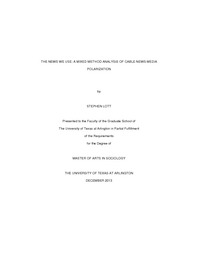
ATTENTION: The works hosted here are being migrated to a new repository that will consolidate resources, improve discoverability, and better show UTA's research impact on the global community. We will update authors as the migration progresses. Please see MavMatrix for more information.
Show simple item record
| dc.contributor.author | Lott, Stephen | en_US |
| dc.date.accessioned | 2014-03-12T23:50:02Z | |
| dc.date.available | 2014-03-12T23:50:02Z | |
| dc.date.issued | 2014-03-12 | |
| dc.date.submitted | January 2013 | en_US |
| dc.identifier.other | DISS-12489 | en_US |
| dc.identifier.uri | http://hdl.handle.net/10106/24105 | |
| dc.description.abstract | The 2012 election is done and the dust has settled, but one cannot overlook the fact that the ever-widening gap between our two main political parties' ideologies and platforms has made it substantially harder for independents and moderates to find their place in the field of politics. The cable news media are complicit in this polarization process by reducing coherent and productive discourse on the issues to ignorant shouting matches between "conservative" republicans and "liberal" democrats, leaving no room for informed discussion or compromise. The 2012 election coverage is a near perfect example of this process, as it was a time in which politically charged dialogue was at its peak, and both major political parties used the polarized atmosphere to mobilize their voter bases against the opposition. Special interest groups and media outlets were especially divisive, often leading in news commentators or companies overtly supporting one candidate, political party, or beliefs concerning an issue over the other, as was the case in Chick-fil-a's and Oreo's stance on Gay rights. This study attempts to explain the motives and effects of the cable news media polarization and how commentators go about building the narratives that become "the news."The analysis is informed by the results of a pretest assessing the quantitative hypothesis that there are differences in the level or intensity of divisiveness in the language used by commentators of news programs. It is guided by a range of sociological theories and concepts, including social referencing, social constructionism, narrative building, symbolic interactionism of political dialogue, moral panic, and social psychological heuristics. Methods include not only a quantitative analysis of cable news media representations, in order to discern statistically significant differences in the frequency of divisive language used by CNN, FOX, and MSNBC, but also a theoretical discussion based on a qualitative assessment of the construction of narratives and persuasion strategies. | en_US |
| dc.description.sponsorship | Young, Robert | en_US |
| dc.language.iso | en | en_US |
| dc.publisher | Sociology | en_US |
| dc.title | The News We Use: A Mixed Methods Analysis Of Cable News Media Polarization | en_US |
| dc.type | M.A. | en_US |
| dc.contributor.committeeChair | Young, Robert | en_US |
| dc.degree.department | Sociology | en_US |
| dc.degree.discipline | Sociology | en_US |
| dc.degree.grantor | University of Texas at Arlington | en_US |
| dc.degree.level | masters | en_US |
| dc.degree.name | M.A. | en_US |
Files in this item
- Name:
- Lott_uta_2502M_12489.pdf
- Size:
- 592.3Kb
- Format:
- PDF
This item appears in the following Collection(s)
Show simple item record


